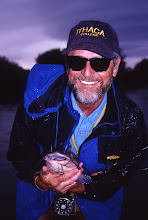Just back from an interesting and unique fishing experience. Dale Robinson, Fishing Manager of the Orvis flagship store in Manchester, Vermont, hooked me up with Drew Price of Master Class Angling. Drew is a guide who, as Vermont’s first certified Master Angler, loves to guide for “alternative species” like carp, gar and bowfin. When Dale told me about bowfin, I knew that was the alternative for me.
Why bowfin? Because it is a smart, primitive, aggressive, hard-fighting fish that grows to respectable size and willingly takes a fly. Also because it’s got teeth, is attractive in an odd sort of way, is a contemporary of the dinosaurs, and I’ve never caught one before.
Drew, a science teacher by training, has studied these fish and knows their habits. He says the bowfin is found throughout Lake Champlain as well as much of the eastern United States, including the Mississippi River drainage. In the lake, Drew says they mostly feed on aquatic insects. They also eat crayfish and forage fish.
Drew and I met at Lake Champlain, that is, once I found my way to the launch site. Drew rolled up with his canoe which we quickly dropped by the road, then parked our cars. Drew fishes out of a canoe because two people can stand up, it is quiet and allows him to take his clients into waters inaccessible to other types of craft. Pretty cool setup and made even more stable by a set of plastic pontoons that can be extended on either side.
He showed me his favorite set-up—a relatively simple, workman-like affair. Drew favors an Orvis 8-weight Hydros rod, floating line, short 4-foot leader and weighted fly. A strong, tough leader and fly rod with plenty of backbone are necessary to deal with these bruisers in weed and brush-filled wetlands.
The fishing is relatively simple as well. It is Sight Fishing 101. Angler in front, standing up, scanning the water for one of these toothy critters. Drew standing in back, guiding the canoe through the open and not-so-open flooded wetlands, helping to spot fish as well. When a fish is spotted, the fly is cast. The target area for bowfin is much like the target area for tailing carp—right on the nose. A well cast fly, jigged up and down may get the attention of a fish. You can tell when a bowfin gets excited as it ripples its almost body-length dorsal fin and flares its gills.
The strike is generally seen as well as felt. Drew swears he can hear the powerful jaws clamp down as well. Not so with me—too much rock and roll and gunfire without ear protection. The motion necessary to get a good hookset matches the tenor of the fish—strong and powerful in order to penetrate the bony mouth structure. When hooked, the reaction is immediate. The water boils, the fish surges left, right, to and fro with an almost uncanny ability to wrap the line around every available bit of floating and underwater vegetation. The trick to landing these guys in such places is like what the bass guys do when fishing the slop. Get their head up and the rest of the body will follow.
When it’s time to land the fish, Drew grabs the net and I lead the bowfin into it. Drew brings it aboard, uses pliers to remove the fly, then uses a Boga-Grip to release the fish after it poses for the appropriate cheesecake shots. The Boga-Grip is an essential tool to avoid getting fingers shredded by those diamond-sharp teeth. Bowfin males, when defending the nest from predators, have been known to attack humans.
Vermont has a Master Angler Program that establishes qualifying length requirements for 33 fish species. For bowfin, any fish over 26 inches puts you in the Master Angler category. Drew got me into five fish in the few hours we fished in spite of the wind rippling the water and the clouds blocking the sun. Of those five, I landed four. The two males were each only about two feet long. The two females measured 29 1/8 and 29 3/4 inches—both Master Angler fish.
Bowfin are not for everyone. Some folks call them dogfish, some call them trash fish, some call them swamp muskie. After hooking my first one and seeing the surface of the water erupt and the bend of the 8-weight rod, I call them nothing but fun.
Any fly fisher heading for the east coast who wants a different, completely out of the ordinary and exciting experience should contact Drew for a day on the water. Driving distances from Boston, New York or Philadelphia are modest compared to heading to eastern Montana. And Lake Champlain has just about every other freshwater fish species as well. Contact Drew Price at www.drewpriceonthefly.com. His blog is www.dponthefly.blogspot.com. Email at muskyflies@gmail.com. Phone is 802.324.5651. Dale Robinson can be reached at 802.362.3750.
skip to main |
skip to sidebar

Northwest Fly Fishing Blog
http://blog.seattlepi.com/flyfishing/
The Williams Lawfirm
http://thewilliamslawfirm.com/
About Me

- The Fishing Writer
- First fly-caught fish was a trout on a Brown Bivisible 50 years ago. Aside from some years foolishly spent playing golf, I've been fishing ever since.